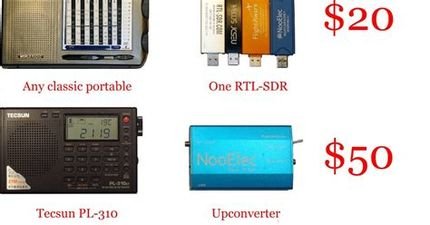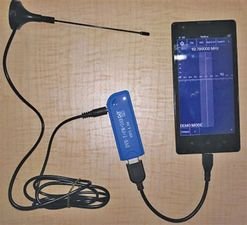This blog will give an intro into using an SDR Dongle with a smartphone (specifically a DVB-T+FM+DAB 820T2 & SDR dongle with an Android phone).
These work great as a portable RX-only radio and allow fine grained spectrum analysis. The dongles are about the size and weight of a BIC lighter and cost about $25 NZD each.
They are designed primarily for use with desktop/laptop computers so for use with a phone they require both a USB-A to USB-C/microUSB adaptor (depending on the smartphone input) and installation of third-party Software such as RF analyser and "rtl-sdr driver" for Android.
A quick overview of SDR vs HDR
HDR (hardware defined radio) is what most people think of when they think of a radio. It has fixed dials, knobs, buttons, switches etc that directly conduct operations. SDR instead uses software to interact with modules and processors on hardware platforms to digitally recreate signals, making it more flexible and programmable but also a bit more complicated to use. However when using GUI based apps (such as RF analyser and GQRX) a user experience similar to HDR can be recreated with additional features and control.
Using it with a phone
The dongle comes as a single unit with an attachable antenna. Once the apps are installed on the phone its simply a matter of plugging the device with the antenna and adaptor attached into the phone and opening the installed app.
If everything is working as intended, the app should detect the dongle and have it available as 'RTL-SDR' in the 'Settings -> Source Type' list. If this is not the case make sure that the phone OS is allowing the USB connection and the RTL-SDR driver is installed correctly. The app should then start detecting signal and producing sound from your phone while also displaying a visual representation of the frequency band and current tune setting. If it is silent check the media volume is up and make sure the -dB gauge is in range.
It's now possible to visit the local AM/FM channels or explore the frequency band to see whats out there. There are plenty of articles explaining SDR in more detail online but the common settings include frequency in Mhz, -dB threshold, band type (AM/FM etc) and other more advanced settings.
There has been some discussion about the possibility that SDR's can damage phones by drawing too much current, so be sure to do research on this before deciding whether its right for your situation. I have not properly tested the draw of the dongle but have used it to analyse frequency without earbuds and found it was fine with no unusual heating. I plan to keep this in consideration but from what I gather this is very rarely a problem.
Closing thoughts
Overall, given the cost and weight of the dongle and its ease of use I think they are a good device for portable/backup/emergency use and a great intro into SDR.
These particular dongles can be used for receiving HDTV and satellite images as well but i'm yet to look into that in much detail. This article explains a process to capture weather satellite images using GNU radio which is an open source Linux program that has a work-in-progress Android version. Further functionality is offered by more expensive SDR hardware platforms but they are larger and don't offer significantly more features for hobby RX use.
The DVB-T+FM+DAB 820T2 & SDR dongles are not hard to find so if you are interested in learning more about SDR or want a good portable radio for your phone then getting one of these dongles is a good start and a useful addition to an EDC or bugout-bag.



